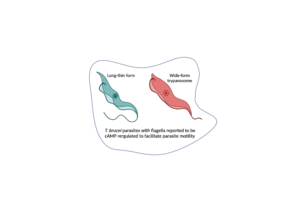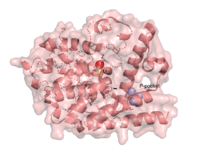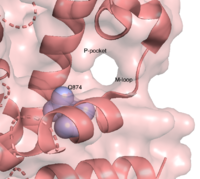T. brucei Phosphodiesterase B1
From Proteopedia
T. brucei PhosphodiesteraseB1
|
Contents |
Function
3′,5′-cyclic nucleotide phosphodiesterases (PDEs) are enzymes that hydrolyse 3',5'-phosphodiester bonds in two of the most important cell signalling molecules, cyclic-adenosine monophosphates (cAMPs) and cyclic-guanosine monophosphates (cGMPs). PDEs are essential for the inactivation of cAMP and or cGMP to regulate their intracellular concentrations and maintain cellular homeostasis [1]. PDEs directly modulate these messenger molecules by degrading cAMP or cGMP when concentrations are elevated beyond the cellular threshold [2]. is one of two cyclic nucleotide phosphodiesterases (the other is TbrPDEB2) that have been validated as promising drug targets for the treatment of Human African Trypanosomiasis (HAT), a life-threatening infectious disease also known as sleeping sickness which is caused by Trypanosoma brucei parasites [3]. PDEB1 is a cAMP-specific hydrolase that catalyses the hydrolysis of cAMP to AMP in the catalytic domain. This enzyme has been reported to play a major role in facilitating Trypanosoma motility in host cells and subsequent progression through the parasite life cycle [4].
Relevance
Trypanosomiasis, or sleeping sickness, is a neglected tropical disease that is fatal if left untreated and is one of the major causes of human and livestock mortality in developing countries. This infection also affects about 72% of European and American tourists who visit safari reserves and game parks in endemic regions [5]. The current treatment options for trypanosomiasis are outdated - such as melarsoprol which was first introduced in 1949- and also sub-optimal typically showing high toxicity, particularly in late-stage infections [6]. There is a clear need for safer, more efficacious drugs to treat sleeping sickness which is why creative studies are being performed to validate new drug targets for trypanosomiasis drug development. PDEB1 makes an interesting drug target for HAT drug discovery due to its essential functions that contribute to parasite fitness and survival.
Structural highlights
There are several resolved crystal structures for TbPDEB1 in both apo and holo forms which facilitate virtual screenings of libraries of compounds for inhibitory activity against TbPDEB1. The resolved crystal structure for the catalytic domain of TbPDEB1 (PDB identifier: 4I15) confirmed the existence of a T. brucei specific P-pocket, a new and exciting direction for improving drug selectivity for T. brucei phosphodiesterases [7].
Only the catalytic domain of the TbPDEB1 enzyme performs the hydrolysis of cAMP to AMP [8]. The active site for TbPDEB1 contains Mg and Zn ions This is a sample scene created with SAT to by Group, and another to make of the protein. You can make your own scenes on SAT starting from scratch or loading and editing one of these sample scenes.
</StructureSection>
Citations
- ↑ Baker DA. Cyclic nucleotide signalling in malaria parasites. Cell Microbiol. 2011 Mar;13(3):331-9. doi: 10.1111/j.1462-5822.2010.01561.x. Epub, 2010 Dec 28. PMID:21176056 doi:http://dx.doi.org/10.1111/j.1462-5822.2010.01561.x
- ↑ Blaazer AR, Singh AK, de Heuvel E, Edink E, Orrling KM, Veerman JJN, van den Bergh T, Jansen C, Balasubramaniam E, Mooij WJ, Custers H, Sijm M, Tagoe DNA, Kalejaiye TD, Munday JC, Tenor H, Matheeussen A, Wijtmans M, Siderius M, de Graaf C, Maes L, de Koning HP, Bailey DS, Sterk GJ, de Esch IJP, Brown DG, Leurs R. Targeting a Subpocket in Trypanosoma brucei Phosphodiesterase B1 (TbrPDEB1) Enables the Structure-Based Discovery of Selective Inhibitors with Trypanocidal Activity. J Med Chem. 2018 May 1. doi: 10.1021/acs.jmedchem.7b01670. PMID:29672041 doi:http://dx.doi.org/10.1021/acs.jmedchem.7b01670
- ↑ Jansen C, Wang H, Kooistra AJ, de Graaf C, Orrling KM, Tenor H, Seebeck T, Bailey D, de Esch IJ, Ke H, Leurs R. Discovery of Novel Trypanosoma brucei Phosphodiesterase B1 Inhibitors by Virtual Screening against the Unliganded TbrPDEB1 Crystal Structure. J Med Chem. 2013 Mar 1. PMID:23409953 doi:http://dx.doi.org/10.1021/jm3017877
- ↑ Shaw S, DeMarco SF, Rehmann R, Wenzler T, Florini F, Roditi I, Hill KL. Flagellar cAMP signaling controls trypanosome progression through host tissues. Nat Commun. 2019 Feb 18;10(1):803. doi: 10.1038/s41467-019-08696-y. PMID:30778051 doi:http://dx.doi.org/10.1038/s41467-019-08696-y
- ↑ Kennedy PGE, Rodgers J. Clinical and Neuropathogenetic Aspects of Human African Trypanosomiasis. Front Immunol. 2019 Jan 25;10:39. doi: 10.3389/fimmu.2019.00039. eCollection, 2019. PMID:30740102 doi:http://dx.doi.org/10.3389/fimmu.2019.00039
- ↑ Kennedy PG. Human African trypanosomiasis of the CNS: current issues and challenges. J Clin Invest. 2004 Feb;113(4):496-504. doi: 10.1172/JCI21052. PMID:14966556 doi:http://dx.doi.org/10.1172/JCI21052
- ↑ Jansen C, Wang H, Kooistra AJ, de Graaf C, Orrling KM, Tenor H, Seebeck T, Bailey D, de Esch IJ, Ke H, Leurs R. Discovery of Novel Trypanosoma brucei Phosphodiesterase B1 Inhibitors by Virtual Screening against the Unliganded TbrPDEB1 Crystal Structure. J Med Chem. 2013 Mar 1. PMID:23409953 doi:http://dx.doi.org/10.1021/jm3017877
- ↑ Kunz S, Luginbuehl E, Seebeck T. Gene conversion transfers the GAF-A domain of phosphodiesterase TbrPDEB1 to one allele of TbrPDEB2 of Trypanosoma brucei. PLoS Negl Trop Dis. 2009 Jun 9;3(6):e455. doi: 10.1371/journal.pntd.0000455. PMID:19513125 doi:http://dx.doi.org/10.1371/journal.pntd.0000455





